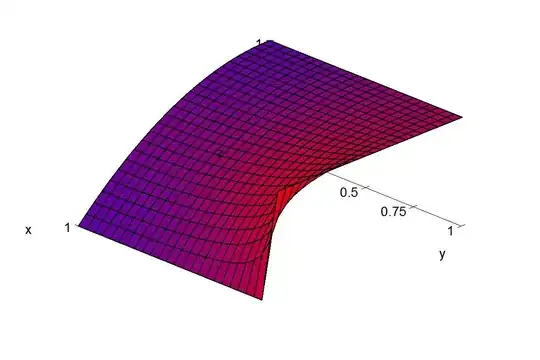The coordinate transformation (due to Beukers, Calabi and Kolk)
$$x=\frac{\sin u}{\cos v}$$
$$y=\frac{\sin v}{\cos u}$$
transforms the square domain $0\lt x\lt 1$ and $0\lt y\lt 1$ into the triangle domain $u,v>0,u+v<\pi /2$ (in Proofs from the BOOK by M. Aigner and G. Ziegler).
Since the invert transformation is
$$u=\arccos \sqrt{\dfrac{1-x^{2}}{1-x^{2}y^{2}}}$$
$$v=\arccos \sqrt{\dfrac{1-y^{2}}{1-x^{2}y^{2}}}$$
it is easy to see that three of the vertices (although not belonging to the domain) are transformed as follows:
$$(x,y)=(0,0)\mapsto (0,0)=(u,v),$$
$$(x,y)=(1,0)\mapsto (\pi /2,0)=(u,v),$$
$$(x,y)=(0,1)\mapsto (0,\pi /2)=(u,v).$$
Question 1 - But how is the fourth vertex $(x,y)=(1,1)$ transformed? In the plot below of $\dfrac{1-x^{2}}{1-x^{2}y^{2}}$ seems that the following limit does not exist
$$\underset{(x,y)\rightarrow (1,1)}{\lim }\sqrt{\dfrac{1-x^{2}}{1-x^{2}y^{2}}}.$$

Question 2 - As a second question I would like to know how can one "discover" a transformation of a square into a triangle such as this. Is there any systematic study of this kind of transformations?